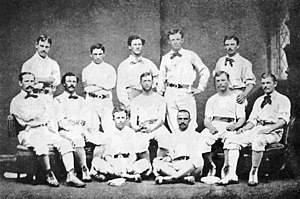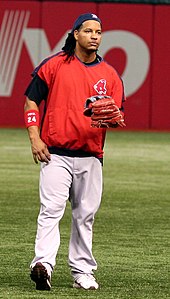Baseball uniform

A baseball uniform is a type of uniform worn by baseball players, and sometimes by non-playing personnel, such as managers and coaches. It is worn to indicate the person's role in the game and, through use of logos and colors, to identify the two teams and officials.[1]
Most baseball uniforms include the player's name and uniform number, usually on the back (and sometimes the front) of the shirt, which helps the spectators identify the different participants within a team. Uniform items typically include shirts, pants, shoes, socks, caps, and gloves.
Baseball uniforms were first worn by the New York Knickerbockers Baseball Club in 1849.[2][3][4] Today, sales of replica uniforms and derivative branded products, generate large amounts of income for Major League teams, through merchandising.
History
Early developments
The New York Knickerbockers were the first baseball team to use uniforms, taking the field on April 4, 1849 in pants made of blue wool, white flannel shirts and straw hats.[2][5][6][2][7] The practice of wearing a uniform soon spread, and by 1900, all Major League Baseball teams had adopted them.[8] By 1882, most uniforms included stockings, which covered the leg, from foot to knee and was used to differentiate one club from another. The uniforms themselves had different colors and patterns that reflected the different baseball positions.[9] In the late 1880s, the Detroit Wolverines and Washington Nationals of the National League and the Brooklyn Bridegrooms of the American Association were the first to utilise striped uniforms.[10][2][11]
Home and road uniforms

By the end of the 19th century, teams began the practice of wearing one of two different uniforms, one when they played in their own baseball stadium and a different one when they played on the road. It became common to wear white at home and one of gray, solid dark blue, or black on the road.[12] An early examples of this is the Brooklyn Superbas, who started to use a blue pattern for their road uniforms in 1907.[8]
In 1916, on the Giants' road uniforms, purple lines gave their uniforms a tartan-like effect and another kind of road uniform was a solid dark blue or black material with white around this time. The Kansas City Athletics home and road uniforms were changed by Charles O. Finley in 1963, to the colors of gold and green.[13] Some teams used light blue for their road uniforms in the 1970s.[8] Early striped patterns developed into long stripes along the length of the uniforms, called pinstriping. This was first worn on some major league baseball team's uniforms in 1907,[12] and the pinstripes were then widened in 1912, so that the crowd could see them more clearly.[12]
The Brooklyn Bridegrooms started to use pinstriping in 1907, 1916 and 1917.[2][11] Satin and other items were added soon after pinstripes were added.[14][2][11] Pinstripes were commonly worn on the uniforms of the New York Yankees. Legend had it that the stripes were adopted to make Babe Ruth look slimmer,[15] but since the Yankees had already been wearing pinstripes a few years before Ruth played for them in 1912, the legend was found to be a myth.[16] The Yankees' pinstripes on their home uniforms soon became a symbol of them and the team.[16]
In 1916, the Cleveland Indians became the first team to add numbers on their uniforms, positioned on the left sleeve of the home uniforms only. (Okkonen, p.36, p.120)[12] In 1929, numbers were first added on the backs of uniforms by the New York Yankees and the Cleveland Indians.[17] By 1932, all major league baseball teams had numbers on their players' uniforms.[8][17] The Brooklyn Dodgers, in 1952, became the first baseball team to add numbers to the fronts of their uniforms.[18][19][20]
Cap styles

Caps, or other types of headgear with eyeshades, have been a part of baseball uniforms from the beginning.[21][22] Baseball teams often wore full-brimmed straw hats or no cap at all since there was no official rule regrding headgear.[23]
From the 1840s to the 1870s, baseball players various types of hats, such as straw hats, boating caps, jockey caps, and even cycling caps. Caps, or other types of headgear with eyeshades, have been a part of baseball uniforms since the beginning.[24][25] The Brooklyn Excelsiors were the first team to wear what would later become the baseball cap, with its distinctive rounded top and peak, in the 1860s.[26]
By the early years of the twentieth century, it became common for players to wear hats with rounded tops, but some persisted with flat-topped caps, such as the Giants in 1916, and the Pittsburgh Pirates as recently as during the 1979 World Series.[12] In recent years, baseball caps have changed very little,[12] although over time, the peak has enlarged slightly to further protect the player's eyes from the sun.[27]

Shoes
In the late 19th century, soft but durable leather shoes were the preferred choice of baseball players. Detachable spikes became popular in the twentieth century, as they helped players to avoid slipping, especially on turf, but they were banned in 1976.[citation needed]
As artificial turf became prominent in baseball fields, modifications to footwear became necessary.[28]
In the 19th century and the first part of the 20th, baseball shoes were commonly black in color. The Kansas City Athletics designed revolutionary white shoes in the 1960s.[29] Today, very few major leaguers wear color-matching shoes and there are hardly any all-black shoes.
Stockings

Inspired by the Cincinnati Red Stockings, the stocking colors of teams in the 1860s onward were a principal device in distinguishing one team from another (hence team names such as Chicago White Stockings, St. Louis Brown Stockings (or Browns), etc.). Except for a few "candy-cane” varieties (particularly by the Giants, St. Louis Cardinals and Washington Senators), striping was quite minimal during the 1920s and, in contrast, a revival of other sorts in the early '30s.[30]
By the 1990s, new styles of close-trimmed pants legs made it possible for players to wear pants that ran clear to the shoetops, in lieu of the traditional knee-breeches style that had prevailed for generations. This led to a violation of the literal concept of a "uniform", in that different players on a given team might wear knee-length and full-length pants on the field at the same time. Players such as Manny Ramirez have taken this fashion trend to an extreme, wearing loose-fitting pants whose legs nearly lap under the heels of the shoes. Meanwhile, players such as Alfonso Soriano continue to wear the traditional knee-breeches.

Graphics and logos

From the beginning, graphic designs were used to identify teams. Often an Old English letter was worn on the chest. This style survives with the Detroit Tigers and their gothic style "D" on their home shirts. Road jerseys were more likely to identify the city, as with the Tigers wearing the word "Detroit" on their road shirts.
As official nicknames gained prominence in the early 1900s (in contrast to media-generated and unofficial nicknames of prior generations), pictorial logos began emerging as part of the team's marketing. Some early examples include a small red tiger on the black cap of the 1901 Detroit Tigers, as they were officially the Tigers from the beginning; and a bear cub logo on the Chicago Cubs shirts by 1907, as that unofficial nickname was then adopted officially by the club.
In another famous example, the Boston Americans (an unofficial designation that merely distinguished them from their across-the-tracks rivals) adopted the Nationals' abandoned red stockings in 1908, and have been the Boston Red Sox officially ever since then.[31]
By the 1930s, nearly every team had distinctive logos, letters or the team nickname on their home shirts, as part of the team's marketing. The trend of the city name on the road jerseys continued. In recent years, with team nicknames being so strongly associated with the clubs, logos that were once only used at home also turned up on road jerseys, in place of city names.
Modern merchandising
See also
- Throwback uniform
- History of baseball team nicknames (includes further detail about major league team uniforms and colors)
Notes
- Marc Okkonen, Baseball Uniforms of the 20th Century: The Official Major League Baseball Guide, 1991.
References
- ^ Robert Riles (8 April 2008). "The American Chronicle". www.americanchronicle.com. Retrieved 2008-06-25.
{{cite web}}: Check date values in:|date=(help) - ^ a b c d e f "Baseball Uniforms in the Major Leagues: The Evolution of the Battle Suit". www.articlesbase.com. Retrieved 2008-07-15.
- ^ "Date when the New York Knickerbockers wore the first baseball uniforms and what they were made of". iterpret.co.za. Retrieved 2008-06-30.
- ^ "History Of Baseball Uniforms In The Major Leagues". interpret.co.za. Retrieved 2008-05-02.
- ^ "Date when the New York Knickerbockers wore the first baseball uniforms and what they were made of". iterpret.co.za. Retrieved 2008-06-30.
- ^ "History Of Baseball Uniforms In The Major Leagues". interpret.co.za. Retrieved 2008-05-02.
- ^ "The history of the baseball uniform at the National Baseball Hall of Fame". exhibits.baseballhalloffame.org. Retrieved 2008-06-14.
- ^ a b c d "Baseball Uniforms of the 20th Century by Baseball Almanac". www.baseball-almanac.com. Retrieved 2008-05-02.
- ^ "The history of the baseball uniform at the National Baseball Hall of Fame". exhibits.baseballhalloffame.org. Retrieved 2008-05-11.
- ^ "National Baseball Hall of Fame - Dressed to the Nines - Uniform Database". exhibits.baseballhalloffame.org. Retrieved 2008-05-02.
- ^ a b c "History Of Baseball Uniforms In The Major Leagues". www.isnare.com. Retrieved 2008-07-15.
- ^ a b c d e f "Baseball uniforms at Baseball Almanac.com". baseball-almanac.com. Retrieved 2008-05-28.
- ^ "Charlie Finley: Baseball's Barnum". Time.com. Monday, Aug. 18, 1975. Retrieved 2008-06-28.
{{cite web}}: Check date values in:|date=(help) - ^ "History of Pinstriping". www.customauthenticjerseys.com. Retrieved 2008-06-29.
- ^ "New York Yankees using pinstripes to make Babe Ruth look slimmer". query.nytimes.com. Retrieved 2008-07-14.
- ^ a b "Major League Baseball history of pinstripes". www.customauthenticjerseys.com. Retrieved 2008-08-13.
- ^ a b "MLB Uniform History - Jersey Numbers". www.customauthenticjerseys.com. Retrieved 2008-07-15.
- ^ "American Chronicle: History of Baseball Uniforms". www.americanchronicle.com. Retrieved 2008-07-10.
- ^ "Baseball Uniforms - History of Baseball Uniforms". www.pr-inside.com. Retrieved 2008-05-02.
- ^ "National Baseball Hall of Fame - Dressed to the Nines - Parts of the Uniform". Baseball Hall of Fame. Retrieved 2008-05-02.
- ^ "A short history of the baseball cap.(The Home Forum) - The Christian Science Monitor — HighBeam Research". www.highbeam.com. Retrieved 2008-05-02.
- ^ "BBC NEWS". news.bbc.co.uk. Retrieved 2008-05-02.
{{cite web}}: Text "Happy 50th, baseball caps" ignored (help); Text "Magazine" ignored (help); Text "UK" ignored (help) - ^ "Celebrating the rich history of baseball caps". mlb.mlb.com. Retrieved 2008-06-29.
- ^ "A short history of the baseball cap.(The Home Forum) - The Christian Science Monitor". www.highbeam.com. Retrieved 2008-05-02.
- ^ "BBC NEWS". news.bbc.co.uk. Retrieved 2008-05-02.
{{cite web}}: Text "Happy 50th, baseball caps" ignored (help); Text "Magazine" ignored (help); Text "UK" ignored (help) - ^ "History of baseball caps". www.srfboy.com. Retrieved 2008-06-29.
- ^ "History of baseball caps and how it is made". www.madehow.com. Retrieved 2008-06-29.
- ^ "Baseball Shoes". Baseball information. Baseball.mu. Retrieved 2008-05-03.
- ^ "Victory Custom Athletic - Baseball Uniforms - Baseball Team Uniforms". www.victory-la.com. Retrieved 2008-05-02.
- ^ "www.villagevoice.com". www.villagevoice.com. Retrieved 2008-05-03.
- ^ "History of the Boston Americans and their uniforms". www.redsoxnation.com. Retrieved 2008-05-27.
External links
- History of the Baseball uniform at the National Baseball Hall of Fame
- ESPN: A pain in the butt(on) - history and potential nuisances of the baseball jersey
